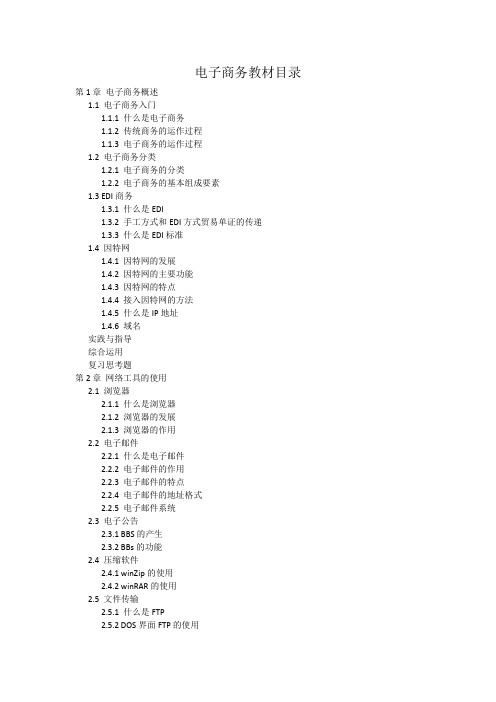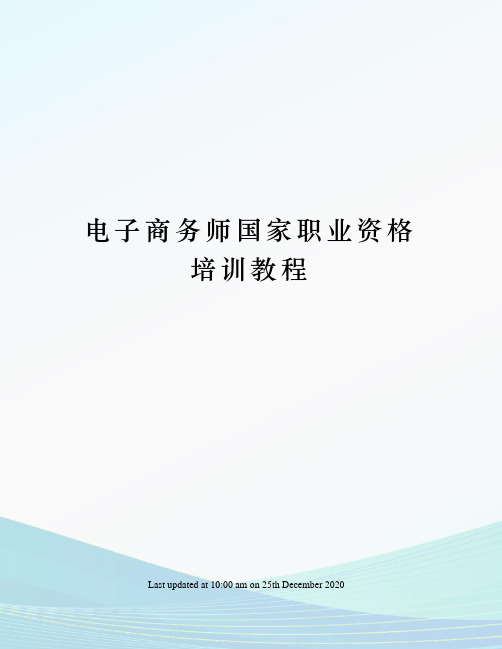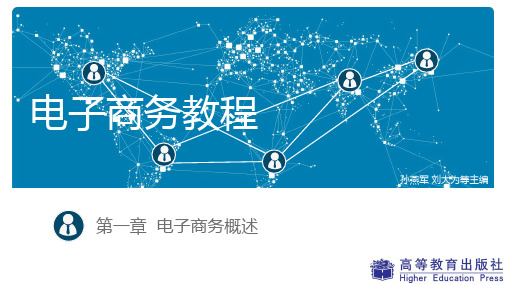电子商务教程第一章
《电子商务概论》教案第一章

教学班级:教学课题:电子商务的产生与发展电子商务的定义教学目的要求:通过学习了解电子商务产生的原因、电子商务的发展情况、掌握电子商务的定义教学重点:电子商务的定义教学难点:电子商务的内涵教学内容:第一节电子商务概述一、电子商务的产生与发展(一)电子商务的产生电子商务产生的原因:1、区域性商贸业务发展的需要2、信息管理系统的发展为电子商务提供了技术基础3、国际互联网和电子数据交换技术为电子商务奠定了物质基础(二)电子商务发的发展1、发展历程目前,人们所提及的电子商务多指在网络上开展的商务活动,即通过企业内部网(Intranet ),外部网(Extranet)以及Internet进行的商务活动就是电子商务。
然而,在电子商务的定义中已经阐述过,电子商务还有广义的定义,即一切利用电子通讯技术使用电子工具进行的商务活动,都可以称为电子商务。
对于广义定义的电子商务,纵观其发展历史,可以分为三个发展阶段。
(1)早期电子商务早在1839年,当电报刚出现的时候,人们就开始了运用电子手段进行商务活动当买卖双方贸易过程中的意见交换、贸易文件等开始以莫而斯码形式在电线中传输的时候,就有了电子商务的萌芽。
①电报②电话③传真④电视(2)专用网络与EDI电子商务EDI是Electronic Data Interchange 的缩写,中文一般译为"电子数据交换" ,有时也称为"无纸贸易"。
①20世纪70年代——EDI技术的开发。
②70年代末和80年代——兴起“无纸贸易”热潮。
(3)Internet的电子商务发展20世纪90年代,Internet是一个连接无数个、遍及全球范围的广域网和局域网的互联网络。
Internet网的兴起将分布于世界各地的信息网络、网络站点、数据资源和用户有机地联为一个整体,在全球范围内实现了信息资源共享、通信方便快捷,因而它已经成为目前人们工作、学习、休闲、娱乐,相互交流以及从事商业活动的主要工具。
电子商务第一章 ppt课件

电子商务特征 电子商务国际特征
语言 资金
接入技术 广告与电子商务的整合
第一次浪潮
第二次浪潮
主要是美国公司
大部分网站都是英 语
很多公司靠外部投 资创立的
各国企业参与电 子商务
很多网站都有多 种语言
现有企业用自己 的资金启动电子
商务计划
低速接入网络
网络宽带接入方 式迅速增长
过分依赖在线广告 采用多种复杂的 作为主要收入来源 广告方式,同电
1.3 电子商务的国际化性质
• 网上的信任问题
1.3 电子商务的国际化性质
• 语言问题
全球70亿人当中只有3.7亿人的母语是英语 目前网上60%的内容是英语,但50%以上的网民不懂英语
有关营销、产品介绍和品牌的页面应该优先翻译,当地内容 的网页应该只有当地语言
本地化(localization)
• 主动标签 • 被动标签 • 市场上一般用得较多的是被动式标签,造价低,
易于配置 • 系统一般都由信号发射机、信号接收机、发射
接收天线几部分组成 • RFID芯片可以是只读,也可以是读/写方式的
特点: 可识别高速运动物体并可同时识别多个标签;
可以节省人工成本; 提高作业精确性; 加快处理速度和有效跟踪物流动态等。
提问及思考
• 为什么亚马逊发展这么迅速? • 电子商务和传统商务的区别? • 电子商务的要素有哪些? • 企业如何发现电子商务的机会?
1.1 电子商务:第二次浪潮
1.1.1回顾电子商务的发展历程: • EDI • 增值网(VAN) • “.com”的泡沫、破灭和重生 • 电子商务第二次浪潮
电子商务两次浪潮的对比
• (2)“拉(Pull)”业务:主要用于信息的个人定制 接收。应用领域包括服务账单、电话号码、旅游信息、 航班信息、影院节目安排、列车时刻表、行业产品信 息等等;
_EC_电子商务教程

1.2.2 电子商务
由上可知,我们所说的电子商务在英文中目前主要有 两个词与之相对应:EB,EC。EB又称广义的电子商务, EC又称狭义的电子商务。一般认为,广义的电子商务概 念是指利用整个IT技术对整个商务活动实现电子化.狭义 的电子商务特指运用因特网开展的交易(或与交易直接有 关的)活动。狭义的电子商务仅仅将在Internet上进行的 交易活
2.电子商务开展的经济因素
〔1〕交易的扩大 经济全球化 交易量上升 〔2〕交易标准化的形成
返回
1.1.3电子商务在中国开展的问题
1.技术问题
2.应用问题
5.人才问题
3.法律问题
4.政策问题 返回
1.2 电子商务根本概念
1.2.1 EB、EC 1.2.2 电子商务 1.2.3 IBM公司、HP公司给出的电子商务的定义 1.2.4 其他的电子商务定义
4.平安性:在电子商务中,平安性是一个至关重要的核 心问题,它要求网络能提供一种端到端的平安解决方案, 如加密机制、签名机制、平安管理、存取控制、防火墙、 防病毒保护等等,这与传统的商务活动有着很大的不同。 5.协调性:商务活动本身是一种协调过程,它需要客户 与公司内部、生产商、批发商、零售商间的协调,在电子 商务环境中,它更要求银行、配送中心、通讯部门、技术 效劳等多个部门的通力协作,往往电子商务的全过程是一 气呵成的。
业务流程来减少公司运营本钱和产品开发周期。具体包 括: (1)企业内部网和企业外部网。企业内部网又称 Intranet,内部网上联接的主要是公司的各个部门、分 厂(店)。企业外部网又称Extranet,外部网上连接的主 要是企业的供给商、经常性的客户、企业的商业伙伴, (2)通信系统,包括电子邮件和信息系统。 (3)企业内部资源管理,包括人力资源,资金、设备,材 料等。 3.交易效劳 交易效劳完成网上交易,并提供交易前、交易中、交易 后的各种效劳。主要包括:
《电子商务》教材目录

电子商务教材目录第1章电子商务概述1.1 电子商务入门1.1.1 什么是电子商务1.1.2 传统商务的运作过程1.1.3 电子商务的运作过程1.2 电子商务分类1.2.1 电子商务的分类1.2.2 电子商务的基本组成要素1.3 EDI商务1.3.1 什么是EDI1.3.2 手工方式和EDI方式贸易单证的传递1.3.3 什么是EDI标准1.4 因特网1.4.1 因特网的发展1.4.2 因特网的主要功能1.4.3 因特网的特点1.4.4 接入因特网的方法1.4.5 什么是IP地址1.4.6 域名实践与指导综合运用复习思考题第2章网络工具的使用2.1 浏览器2.1.1 什么是浏览器2.1.2 浏览器的发展2.1.3 浏览器的作用2.2 电子邮件2.2.1 什么是电子邮件2.2.2 电子邮件的作用2.2.3 电子邮件的特点2.2.4 电子邮件的地址格式2.2.5 电子邮件系统2.3 电子公告2.3.1 BBS的产生2.3.2 BBs的功能2.4 压缩软件2.4.1 winZip的使用2.4.2 winRAR的使用2.5 文件传输2.5.1 什么是FTP2.5.2 DOS界面FTP的使用2.5.3 图形界面FTF的使用2.6 下载工具2.6.1 网络蚂蚁的主要特点2.6.2 使用网络蚂蚁2.7 邮件列表2.7.1 如何划分邮件列表2.7.2 创建自己的邮件列表2.8 Fox**的使用2.8.1 建立一个新用户2.8.2 设置与使用Fox**实践与指导综合运用复习思考题第3章网上支付3.1 网上银行3.1.1 网上银行的特点3.1.2 网上银行的基本业务3.2 网上支付3.2.1 网上支付系统3.2.2 电子货币3.3 银行卡的使用3.3.1 银行卡的发展3.3.2 信用卡网上购物流程3.3.3 易购365——招商银行网上支付系统实践与指导综合运用复习思考题第4章电子商务模式4.1 B2c电子商务4.1.1 B2c电子商务的基本组成4.1.2 B2c电子商务的购物流程4.1.3 上海书城购书4.2 B2B电子商务4.2.1 B2B电子商务交易的优势4.2.2 B2B电子商务的交易模式4.2.3 上海中昊化工网上交易中心(sccN)模式4.3 C2C电子商务4.3.1 C2C电子商务的交易概述4.3.2 C2c电子商务的经营模式实践与指导综合运用复习思考题第5章电子商务信息安全5.1 电子商务安全概述5.2 密码密钥体系5.2.1 密码系统的工作原理5.2.2 通用密钥密码体制5.2.3 公开密钥密码体制5.3 数字摘要与数字证书5.3.1 数字摘要5.3.2 数字签名5.3.3 数字证书5.3.4 信息窃密5.4 电子商务安全协议5.4.1 SSL协议5.4.2 SET协议实践与指导综合运用复习思考题第6章网络营销6.1 网络营销概念6.1.1 网络营销的主要内容6.1.2 网络营销的特点6.2 网络市场调研6.2.1 网络市场调研的程序6.2.2 网络市场调研与传统调研的比较6.2.3 网络市场调研的特点6.3 网络营销策略6.3.1 产品策略6.3.2 定价策略6.3.3 分销策略6.3.4 促销策略6.4 网络广告6.4.1 网络广告的特点6.4.2 网络广告的发布6.5 网络信息收集6.5.1 如何查找信息6.5.2 如何使用搜索引擎实践与指导综合运用复习思考题第7章电子商务物流7.1 物流的基本概念7.1.1 物流活动的要素7.1.2 电子商务下的物流特点7.2 电子商务与物流配送7.2.1 物流在电子商务中的作用7.2.2 电子商务对物流配送的影响7.2.3 电子商务下的新型配送中心应具备的条件7.2.4 易购365的电子商务与物流配送实践与指导综合运用复习思考题第8章网上建店实务8.1 买买乐(mymyle)简介8.1.1 买买乐的基本服务8.1.2 买买乐的增值内容8.1.3 网上虚拟店面的主要功能8.2 申请开店8.2.1 填写注册信息8.2.2 填写开店申请表8.3 商店管理8.3.1 填写商店信息8.3.2 上传logo8.3.3 设定背景音乐8.3.4 设定进站画面8.3.5 设定客服中心内容8.3.6 设定帮助中心内容8.3.7 设定本店的送货方式8.3.8 设定本店的付款方式8.3.9 设定友情链接8.3.10 修改密码8.4 商品管理8.4.1 添加新商品8.4.2 删改商品信息8.4.3 进行零售价管理8.4.4 对新建商品进行组合8.4.5 设置商品组合8.5 店面管理8.5.1 装修店面8.5.2 使用公用导航条8.5.3 在首页设置店主问候语8.5.4 在首页显示图片8.5.5 在首页进行商品组合8.5.6 在首页推荐商品8.5.7 在首页标记特色商品8.5.8 在首页标记新品到货8.5.9 进入我的商店实践与指导综合运用复习思考题第9章电子商务模拟模拟1 银行卡网上购物模拟2 电子钱包网上购物模拟3 商品管理模拟4 个人cA证书申请及审批模拟5 个人CA证书下载及安装模拟6 企业CA证书。
电子商务第一章

移动电子商务
无线因特网迅速发展 固定+移动电子商务
电子商务的特点
“无须远行,无须就等” 迅速扩展的市场和庞大的消费者群 高度自主、自立、自由的市场环境 虚拟与现实相结合 直接与间接相结合 大众化与个性化组合 动态与静态相结合
电子商务的基本作用
节约社会劳动和经济资源 节省时间 加快科技知识传播,促进知识经济的发展 弱化地理限制,合理配置社会资源 促进社会分工和新行业的产生
FA工厂自动化 OA办公室自动化 FA家庭自动化
网络经济的定义
建立在网络基础上并由此产生的一切经济 活动的总和
不具备信息技术的服务经济不是网络经济, 而没有服务的信息经济也不是网络经济
网络经济的本质
是信息经济和服务经济的有机结合 是一种新的生产方式 也是一种全新的生产力
网络经济的特点
电子商务涵盖的范围
企业对企业(Business-to-Business,即B2B) 企业对消费者(Business-to-Consumer,即
B2C) 个人对消费者(Consumer-to-Consumer,即
C2C) 企业对政府(Business-to-Government) C2G和G2G
电子商务对消费者的影响
消费者能在网络上直接面对所有的相关商 家
足不出户就能最大限度地进行对比和挑选
电子商务对政府机构的影响
政府机构的业务转型 政府的政策导向 政府机构担任认证中心
电子商务的市场变化
交易的环境条件不同 交易的支付方式不同 交易的时域空间不同 人员结构和营销重点不同
报酬递增的原因 网络经济下的正反馈原理 良性循环带来的收益递增
网络经济中的其他定律
摩尔定律 物以多为贵——建立统一标准最重要 价格永恒降低 完全信息或充分信息市场
电子商务基础教学教案(全)

电子商务基础教学教案(第一部分)第一章:电子商务概述一、教学目标1. 了解电子商务的定义和发展历程。
2. 掌握电子商务的基本组成部分和运作流程。
3. 了解电子商务的分类和应用领域。
二、教学内容1. 电子商务的定义和发展历程电子商务的定义电子商务的发展阶段电子商务的发展趋势2. 电子商务的基本组成部分网络基础设施信息安全技术支付系统物流与供应链管理3. 电子商务的运作流程商机发掘客户需求分析网络市场调研网络营销策略交易洽谈与合同签订支付与结算售后服务与客户关系管理4. 电子商务的分类和应用领域B2B(企业与企业间电子商务)B2C(企业与消费者间电子商务)C2C(消费者与消费者间电子商务)O2O(线上与线下融合电子商务)其他电子商务模式三、教学方法1. 讲授法:讲解电子商务的定义、发展历程、基本组成部分和运作流程。
2. 案例分析法:分析典型电子商务案例,加深对电子商务模式和应用领域的理解。
3. 讨论法:分组讨论电子商务的优势、劣势、机会和威胁,培养学生的批判性思维。
四、教学资源1. 教材:电子商务基础2. 课件:电子商务概述3. 案例材料:典型电子商务案例五、教学评估1. 课堂参与度:评估学生参与课堂讨论的积极程度。
2. 小组报告:评估学生对典型电子商务案例的分析能力。
第二章:网络营销策略一、教学目标1. 了解网络营销的基本概念和目标。
2. 掌握网络营销的主要策略和方法。
3. 了解网络营销的效果评估和优化方法。
二、教学内容1. 网络营销的基本概念和目标网络营销的定义网络营销的目标网络营销与传统营销的比较2. 网络营销的主要策略和方法搜索引擎优化(SEO)搜索引擎营销(SEM)社交媒体营销(SMM)内容营销电子邮件营销网络广告3. 网络营销的效果评估和优化方法网络营销效果评估指标数据挖掘与分析网络营销优化策略三、教学方法1. 讲授法:讲解网络营销的基本概念、目标、策略和方法。
2. 案例分析法:分析成功网络营销案例,学习其经验和教训。
《电子商务概论》教案第一章

教学班级:教学课题:电子商务的产生与发展电子商务的定义教学目的要求:通过学习了解电子商务产生的原因、电子商务的发展情况、掌握电子商务的定义教学重点:电子商务的定义教学难点:电子商务的内涵教学内容:第一节电子商务概述一、电子商务的产生与发展(一)电子商务的产生电子商务产生的原因:1、区域性商贸业务发展的需要2、信息管理系统的发展为电子商务提供了技术基础3、国际互联网和电子数据交换技术为电子商务奠定了物质基础(二)电子商务发的发展1、发展历程目前,人们所提及的电子商务多指在网络上开展的商务活动,即通过企业内部网(Intranet ),外部网(Extranet)以及Internet进行的商务活动就是电子商务。
然而,在电子商务的定义中已经阐述过,电子商务还有广义的定义,即一切利用电子通讯技术使用电子工具进行的商务活动,都可以称为电子商务。
对于广义定义的电子商务,纵观其发展历史,可以分为三个发展阶段。
(1)早期电子商务早在1839年,当电报刚出现的时候,人们就开始了运用电子手段进行商务活动当买卖双方贸易过程中的意见交换、贸易文件等开始以莫而斯码形式在电线中传输的时候,就有了电子商务的萌芽。
①电报②电话③传真④电视(2)专用网络与EDI电子商务EDI是Electronic Data Interchange 的缩写,中文一般译为"电子数据交换" ,有时也称为"无纸贸易"。
①20世纪70年代——EDI技术的开发。
②70年代末和80年代——兴起“无纸贸易”热潮。
(3)Internet的电子商务发展20世纪90年代,Internet是一个连接无数个、遍及全球范围的广域网和局域网的互联网络。
Internet网的兴起将分布于世界各地的信息网络、网络站点、数据资源和用户有机地联为一个整体,在全球范围内实现了信息资源共享、通信方便快捷,因而它已经成为目前人们工作、学习、休闲、娱乐,相互交流以及从事商业活动的主要工具。
电子商务师国家职业资格培训教程

电子商务师国家职业资格培训教程Last updated at 10:00 am on 25th December 2020第一章网页制作第一节HTML语言一.页面布局1.成对标记与非成对标记在使用上有何不同下列标记符中哪些是成对标记符,哪些是非成对标记符<title>、<hi>、<p>、<br>、<ul>、<ol>、<li>。
答题思路:非成对标记符是 <br> ,其他都为成对标记符。
2.<br>和<p>…</p>有何区别?答题思路:<br>标记符用于定义文本从新的一行显示,它不产生一个空行,但连续多个的<br>标记符可以产生多个空行的效果。
<P>标记符用于划分段落,控制文本的位置。
<P>是成对标记符,用于定义内容从新的一行开始,并与上段之间有一个空行。
3.试用HTML编写一个简单的网页。
答题思路:略。
二.文字与表格1.HTML文件中的标记是否区分大小写?答题思路:标记符忽略大小写。
2.编辑HTML文件时应注意什么问题?答题思路:存盘时用.html或.htm为后缀,注意成对标记符的正确使用等。
3.试用HTML编写一个简单的表格网页。
答题思路:略。
第二节动态网页制作一.编辑图像1.静态网页和动态网页有何区别?答题思路:动态网页,将内容对象化,应用编程语言来操作页面上的对象,不必通过服务器就可以与用户交互信息,更新页面的内容。
静态网页一旦被下载到客户端浏览器后,就无法改变显示内容。
2.DHTML的基本结构。
答题思路:DHTML的基本结构包括HTML、CSS、脚本程序、浏览器对象和网页对象等。
DHTML是基于HTML语言,通过CSS技术扩展了HTML的样式定义语法和语义,使用脚本程序调用或控制浏览器对象和网页对象,从而使页面具有动态效果和交互功能。
电子商务教程(第二版) 第1-4章

改 变 企 业 的 运 作 方 式
直接向消费者和企业销售实物产品 为个人和企业提供产品、价格等信息,由广告费和 交易介绍费获利 提供一个在线场所,兴趣相投的可以沟通和发现有 用信息 以数字内容创收,如数字新闻、音乐、照片、影像 等。 为个人和企业提供在线服务,由订阅或交易费、广 告、由顾客处收集信息获得收入 提供入网进口,囊括各方内容,提供各种服务,可 转接其他网站 提供买卖双方会聚的环境,查找产品,显示产品及 价格。提供拍卖和拍买。
姓名 职务
姓名 职务 姓名 职务
姓名 职务 姓名 职务
姓名 职务
向 扁 平 化 发 展
——
姓名 职务 姓名 职务 姓名 职务 姓名 职务 姓名 职务 姓名 职务 姓名 职务 姓名 职务 姓名 职务 姓名 职务 姓名 职务 姓名 职务 姓名 职务
图1-8 组织偏平化
引例
电商兴起
电商涵义
电商要素
电商特性
主机/微机(1950至 今)
互 联 网 和 技 术 汇 聚 催 生 电 子 商 务
——
个人计算机(1981年至今)
主机/微机(1950至 今)
个人计算机(1981年至今)
客户机/服务器(1983年至今)
因特网(1992年至今)
个人计算机(1981年至今)
企业服务器 因特网
客户机/服务器(1983年至今)
社会影响
拓展阅读
改 变 消 费 方 式
在线购物必然是人们消费的方式之一 。
现实购物不会消失。 两种消费方式并存 。
引例
电商兴起
电商涵义
电商要素
电商特性
社会影响
拓展阅读
改 变 市 场 准 入 条 件
在电子商务模式中,这些中小企业可以通过很廉价的
电子商务基础教程-第一章-电子商务概述

• 3.企业管理信息化的需要 4
二、 电子商务发展的阶段
• 1.电子商务的最初形式
1839年电 报
10
第二节 电子商务的内涵
11
一、电子商务的概念
• 电子商务有广义和狭义之分。
• 狭 义 的 电 子 商 务 也 称 作 电 子 交 易 ( ECommerce),主要指利用 Web提供的 通信手段在网上进行交易。
• 从广义上讲,电子商务指包括电子交易 在内的利用 Web进行的全部商业活动, 如市场分析、客户联系、物资调配等等, 也称作电子商业(E-Business)。电子
14
二、电子商务的本质
• (1)电子商务的基础——现代信息技术。 • (2)电子商务的核心竞争力——大量掌握现
代信息技术、掌握现代商贸理论与实务的复 合型人才。 • (3)电子商务的目的——商务活动。
15
第三节 电子商务的种类
16
一 按电子商务参加主体来划分
• 1.企业与消费者之间的电子商务。 • 2.企业与企业间的电子商务。 • 3.企业与政府之间的电子商务。 • 4.企业内部的电子商务。 • 可以派生出若干种派生形式,如C2B(Consumer to Business)、
8
我国电子商务发展预测及展望
• (1).电子政务与政府信息化有重大进 展
• (2).电子商务在国民经济各部门逐步 发展
• (3).主要行业企业电子商务有很大发 展
9
电子商务应用水平
• 1)初级电子商务。它主要表现为商务初级电子化、网络化,初步开展 电子商务,主要实现信息流的网络化,即进行网上发布产品信息,网上 签约洽谈,网上营销,网上收集客户信息,实现网络营销等非支付型电 子商务,实现初级经营服务信息化。
电子商务实用技术教程第一章

亚马逊中文网址:
2.案例分析
亚马逊公司的成功秘诀是: 1.了解电子商业。 2.成立企业家团队。 3.创造网络品牌。 4.提供好处以招揽并留住顾客。 5.建立配送网络。
3.案例思考题
⑴亚马逊是如何成功的?结合本案例,说说电子商务的 发展前景。
二、教学内容
掌握电子商务的发展历程
教学 目标
掌握电子商务的概念
电子商务的发展现状
教学 重点 电子商务的概念
电子商务的发展现状
教学 难点 电子商务的概念
1.1 电子商务的发展历程
1.1.1电子商务的产生与发展
1.电子商务产生和发展的条件 (1)计算机应用的普及 (2)网络技术的成熟与普及 (3)电子交易协议的制定 (4)信用卡的普及 (5)政府的支持与推动
第1章 电子商务概述
第1章 电子商务概述
1.1 电子商务的发展历程 1.2 电子商务概念 1.3 电子商务分类 1.4电子商务的基本组成、特点与一般流程
教学进程
一、导入新课
教学情境一
案例1-1 亚马逊公司的成功经验
1994年,普林斯顿大学毕业的计算机与电力工 程专业学生杰夫〃贝佐斯,成为华尔街投资银ቤተ መጻሕፍቲ ባይዱ历 史上最年轻的副总裁。 1994年夏天,他看到网络使用人数以2300%速 度成长。于是他辞掉工作,拟出可以在网上销售的 20种产品,最后决定销售图书和音乐制品。 他来到西雅图开了一家网店,店名为亚马逊。
1.2.1人类商品交易模式的变化
2.商品交易的产生及其模式的变化阶段 (2)“一手交钱、一手交货”的商品交易模式
随着交易范围和规模的不断扩大,出现了以中介进行
商品交换的方式,即“以钱买物”,但是人们是按照“一 手交钱、一手交货”的现金买卖原则,即先付款后提货。 这种商务活动也属于直接交易。
电子商务基础第1章

第一章计算机与网络基础知识本章主要讲述与电子商务活动有关的计算机、网络基础知识。
内容包括计算机系统的组成、计算机硬件的基本组成、计算机软件的基本组成、计算机网络基础知识和通信技术。
一.学习目标掌握计算机系统的组成、计算机硬件的基本组成及各部分的功能描述、计算机软件的分类、计算机网络基础知识和常用的通信技术。
二.重点、难点1.计算机硬件的基本组成2.计算机软件的基本组成3.计算机网络基础知识三.重点、难点解析1.计算机硬件的基本组成(1)中央处理器(CPU)中央处理器称为CPU(Control Processing Unit),它主要由控制器和运算器组成,是计算机的核心部件。
要求学员了解运算器、控制器的功能及CPU的评价指标。
参看教材P2。
(2)存储器存储器(Memory)是用来存储程序和数据的部件,是计算机的重要组成部分。
在实际应用中,用户先通过输入设备将程序和数据放在存储器中,运行程序时,由控制器从存储器中逐一取出指令并加以分析,发出控制命令以完成指令的操作。
在计算机中,存储器容量以字节(Byte,简写为B)为基本单位,一个字节由8个二进制位(bit)组成。
存储容量的表示单位除了字节以外,还有KB、MB、GB、TB(可分别简称为K、M、G、T,例如,128MB可简称为128M)。
其中:1KB=1024B1MB=1024KB1GB=1024MB1TB=1024GB掌握常见存储器的分类。
主存储器主存储器,也称内存储器,简称内存,是微型计算机主机的组成部分。
微型计算机的内存根据其工作方式的不同,可分为RAM和ROM。
辅助存储器由于主存储器的容量有限,所以计算机的外部设备中都配有辅助存储器。
辅助存储器,也称外存储器,简称外存。
外存容量可以很大,能存放大量的暂时不用的程序和数据。
目前,计算机上经常使用的外存有软盘、硬盘和光盘等。
其它辅助存储器随着计算机技术、微电子技术和其它相关技术的发展,新型的辅助存储器不断出现,它们能提供更大的存储容量,更快的数据传输速率。
- 1、下载文档前请自行甄别文档内容的完整性,平台不提供额外的编辑、内容补充、找答案等附加服务。
- 2、"仅部分预览"的文档,不可在线预览部分如存在完整性等问题,可反馈申请退款(可完整预览的文档不适用该条件!)。
- 3、如文档侵犯您的权益,请联系客服反馈,我们会尽快为您处理(人工客服工作时间:9:00-18:30)。
7
Electronic Commerce: Definitions and Concepts
• Pure Versus Partial EC – EC takes several forms depending on the degree of digitization (the transformation from physical to digital)
17
EC Classification consumer-to-business (C2B)
E-commerce model in which individuals use the Internet to sell products or services to organizations or individuals seek sellers to bid on products or services they need
• EC organizations
brick-and-mortar organizations Old-economy organizations (corporations) that perform most of their business off-line, selling physical products by means of physical agents virtual (pure-play) organizations Organizations that conduct their business activities solely online click-and-mortar (click-and-brick) organizations Organizations that conduct some e-commerce activities, but do their primary business in the physical world
14
Exhibit 1.2 A Framework for Exhibit 1.2 A Framework for Electronic Commerce Electronic Commerce
15
EC Classification
• Classification by nature of the transactions or interactions
business-to-business (B2B) E-commerce model in which all of the participants are businesses or other organizations business-to-consumer (B2C) E-commerce model in which businesses sell to individual shoppers
10
Electronic Commerce: Definitions and Concepts
• Where EC is conducted
electronic market (e-marketplace) An online marketplace where buyers and sellers meet to exchange goods, services, money, or information interorganizational information systems (IOSs) Communications system that allows routine transaction processing and information flow between two or more organizations intraorganizational information systems Communication systems that enable e-commerce activities to go on within individual organizations
3
Learning Objectives
5. Describe the business environment as a driver of EC. 6. Describe some EC business models. 7. Describe the benefits of EC to organizations, consumers, and society. 8. Describe the limitations of EC. 9. Describe the contribution of EC to organizations responding to environmental pressures.
12
The EC Framework
intranet
An internal corporate or government network that uses Internet tools, such as Web browsers, and Internet protocols
extranet
A network that uses the Internet to link multiple intranets
4
Electronic Commerce: Definitions and Concepts
electronic commerce (EC) The process of buying, selling, or exchanging products, services, or information via computer networks
(1) the product (service) sold, (2) the process, (3) the delivery agent (or intermediary)
8
Exhibit 1.1 The Dimensions of Electronic Commerce
9
Electronic Commerce: Definitions and Concepts
mobile commerce (m-commerce)
E-commerce transactions and activities conducted in a ____________________
19
EC Classification
location-based commerce (l-commerce)
5
Electronic Commerce: Definitions and Concepts
• EC is defined through these perspectives – Communications – Commercial (trading) – Business process – Service – Learning – Collaborative – Community
16
EC Classification e-tailing
Online retailing, usually B2C
business-to-business-to-consumer (_______________)
E-commerce model in which a business provides some product or service to a client business that maintains its own customers
Electronic Commerce
----A Managerial Perspective (4th Edition)
主讲: 主讲:柯晓华
Chapter 1
Overview of Electronic Commerce
Learning Objectives
1. Define electronic commerce (EC) and describe its various categories. 2. Describe and discuss the content and framework of EC. 3. Describe the major types of EC transactions. 4. Describe the digital revolution as a driver of EC.
consumer-to-consumer (C2C)
E-commerce model in which consumers sell directly to other ers
18
EC Classification peer-to-peer
___________ that enables networked peer computers to share data and processing with each other directly; can be used in C2C, B2B, and B2C e-commerce
13
The EC Framework, Classification, and Content
• An EC Framework—supports five policymaking support areas
– – – – – ____________ Public policy Marketing and advertisement Support services Business partnerships
11
The EC Framework, Classification, and Content
• Networked computing(网格化计算) is the infrastructure for EC, and it is rapidly emerging as the standard computing environment for business, home, and government applications – Networked computing connects multiple computers and other electronic devices located in several different locations by telecommunications networks, including wireless ones – Allows users to access information stored in several different physical locations and to communicate and collaborate with people separated by great geographic distances
